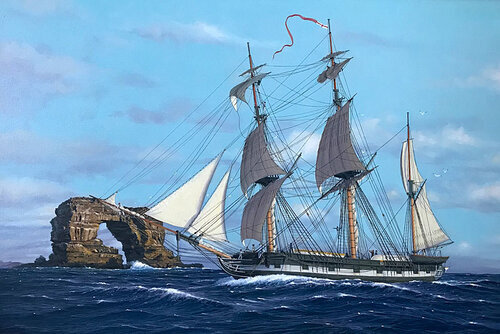Voyage of Discovery; HMS Beagle, 1832
oil, 21" x 30"
SOLD
Charles Darwin sailed the HMS Beagle from Plymouth, England on December 27, 1831 for a year voyage around the world, exploring, recording and analyzing the natural environment, and, animal and plant life that he encountered on his trip. Among the most fascinating places he visited were the Galapagos Islands, a group of volcanic islands six hundred miles off the coast of Ecuador. Although his captain, Robert Fitzroy, described them in the log as “dismal, desolate yet deeply interesting,” the astounding natural formations and variety of wildlife he encountered helped him form his powerful theory of evolution which he described in The Origin of the Species by Natural Selection, published in 1859.
The Beagle is seen in Garnett’s painting as she first approached the island chain on September 15, 1832. It recollects the dark, rainy conditions at the time noted in both Darwin’s and Fitzroy’s log, which described the ocean as being “black like ink” as a storm was just beginning to move off in the distance. Prominent in the painting is a rock formation which has become known as “Darwin’s Arch.”
Beagle was one of a class of British 10-gun brigs, also known as coffin ships’ as they had a reputation for sinking. Beagle, it turns out, though was not a brig at all but was rigged as a bark in that she had three masts, not two, the third being mounted rather far aft with a fore and aft driver. This alteration enabled Beagle to sail much closer to the wind. She had six gun ports on each side as well as two in the bows, and two in the stern. The Artist notes, “Research for the Beagle’s appearance was difficult as I tried to present her at the time Darwin sailed on her, as she was altered many times in her varied career.” The Beagle was launched May 11, 1820 at the Woolwich dockyard below London. By 1825 her hull was already rotten and she had to be reinforced and re-coppered in preparation for her life as a survey ship. First under the command of Pringle Stokes, who along with the HMS Adventure, spent the next four years (1826-30) charting the labyrinth of channels at the tip of South America. When Stokes shot himself in his cabin in 1828, Fitzroy, the 23-year old flag Lieutenant for the HMS Ganges replaced him. The Beagle had one more voyage in her after Darwin. This one was to explore the unknown continent of Australia from which she returned in 1843. Between then and 1870 she served basically as a floating storage and watch vessel. She was eventually sold and dragged onto the tidal flats in Plymouth, where she was salvaged for scrap. Amazingly, the remains of this important vessel are reported to have just recently been discovered and are being excavated by archeologists today.

